It looks like you're using an Ad Blocker.
Please white-list or disable AboveTopSecret.com in your ad-blocking tool.
Thank you.
Some features of ATS will be disabled while you continue to use an ad-blocker.
share:
originally posted by: 0bserver1
a reply to: rickymouse
Do they chemically clean these kind of artifacts?
Usually not. They will stabilize them with certain types of glues, but you really don't want to mess with them too much. Chemical cleaning can leave residues that affect the specimen later on. Sometimes dirt will be deliberately left on if the piece is hard to clean... saving it for later when a newer technique might enable cleaning without damaging.
originally posted by: Wolfenz
originally posted by: intrptr
Sorry if anyone has suggested it already, my guess is the craftsman had a rudimentary magnifying glass, carved from a piece of clear crystal. After all he was a skilled artist, wasn't he?
Since we know rock crystal existed, since we know he also carved in gem stone, it would only take a tiny field of view thru a bit of carved stone to facilitate just enough magnification for the artisan to work on such a tiny figure.
People are saying the 'size of a thumb', are there any images that include a familiar object to compare scale?
Right .. but for WHY was it Made for what Purpose .. ?
any Clue ..
you know what my Hunch is ?
The Gem is Transparent Right ?
...annnnd... we can stop right there. It's not transparent. It's somewhat translucent. It would not project the image and it would take an extremely bright light to actually shine through it.
To get an idea of what it's like, imagine shining a light through a jar of Vaseline. Like agate, Vaseline is translucent and if you slice it reeeeeeallly thin, you can see through it. But not at this thickness.
a reply to: Byrd
I have to say considering the material used and size with that precision almost looks as it's laser cutted?
Did they have magnifying glasses at that time period?
Or did they use techniques by heating the object to then pour it into a mold or something?
I have to say considering the material used and size with that precision almost looks as it's laser cutted?
Did they have magnifying glasses at that time period?
Or did they use techniques by heating the object to then pour it into a mold or something?
edit on 0b13America/ChicagoWed, 15 Nov 2017
02:07:13 -0600vAmerica/ChicagoWed, 15 Nov 2017 02:07:13 -06001 by 0bserver1 because: (no reason given)
originally posted by: 0bserver1
a reply to: Byrd
I have to say considering the material used and size with that precision almost looks as it's laser cutted?
Did they have magnifying glasses at that time period?
Or did they use techniques by heating the object to then pour it into a mold or something?
How about reading the thread? Just a suggestion.
a reply to: Phage
Nothing just find it amazingly crafty and precise. I'm amazed how they pulled it off?
Did they ever found any tools that could been used to make such fine art?
a reply to: FatherLukeDuke
I did but there's only the indication a magnifying glass could be used..
Not that it has been used , they never found one.
And they mention the carvings could only be seen under a microscope. " where's the picture from that research that shows it has been carved science always wants evidence but now lack of giving the evidence themselves at least a few magnifying photographs would be in place?
I magnified it in photoshop and wonder where are the marks of that? Are we not talking about a gemstone carving as I remember diamonds are used to cut through stone what is used to cut through gemstones?
But, I guess I have to trust their word for it, those guys never withold any information for the public eye..
Nothing just find it amazingly crafty and precise. I'm amazed how they pulled it off?
Did they ever found any tools that could been used to make such fine art?
a reply to: FatherLukeDuke
I did but there's only the indication a magnifying glass could be used..
Not that it has been used , they never found one.
And they mention the carvings could only be seen under a microscope. " where's the picture from that research that shows it has been carved science always wants evidence but now lack of giving the evidence themselves at least a few magnifying photographs would be in place?
I magnified it in photoshop and wonder where are the marks of that? Are we not talking about a gemstone carving as I remember diamonds are used to cut through stone what is used to cut through gemstones?
But, I guess I have to trust their word for it, those guys never withold any information for the public eye..
edit on 0b35America/ChicagoWed, 15 Nov 2017 08:53:35 -0600vAmerica/ChicagoWed, 15 Nov 2017 08:53:35 -06001 by 0bserver1 because: (no
reason given)
Congratulations. We found something in the ground. Must mean that, there were people living there, in the past.
looks like they had, advanced tools to manufacture sophisticated artifacts.
It could be made by humans, by the depicting of humans on the aggate.
Interesting.
This is my first comment
looks like they had, advanced tools to manufacture sophisticated artifacts.
It could be made by humans, by the depicting of humans on the aggate.
Interesting.
This is my first comment
originally posted by: Runestone
Congratulations. We found something in the ground. Must mean that, there were people living there, in the past.
looks like they had, advanced tools to manufacture sophisticated artifacts.
It could be made by humans, by the depicting of humans on the aggate.
Interesting.
This is my first comment
Interesting choice of comma placements?
Can you tell us something about yourself?
originally posted by: Byrd
originally posted by: Wolfenz
originally posted by: intrptr
Sorry if anyone has suggested it already, my guess is the craftsman had a rudimentary magnifying glass, carved from a piece of clear crystal. After all he was a skilled artist, wasn't he?
Since we know rock crystal existed, since we know he also carved in gem stone, it would only take a tiny field of view thru a bit of carved stone to facilitate just enough magnification for the artisan to work on such a tiny figure.
People are saying the 'size of a thumb', are there any images that include a familiar object to compare scale?
Right .. but for WHY was it Made for what Purpose .. ?
any Clue ..
you know what my Hunch is ?
The Gem is Transparent Right ?
...annnnd... we can stop right there. It's not transparent. It's somewhat translucent. It would not project the image and it would take an extremely bright light to actually shine through it.
To get an idea of what it's like, imagine shining a light through a jar of Vaseline. Like agate, Vaseline is translucent and if you slice it reeeeeeallly thin, you can see through it. But not at this thickness.
and then ..... ohh WIKI!
Agate
en.wikipedia.org...
Greek agate is a name given to pale white to tan colored agate found in Sicily back to 400 BC. The Greeks used it for making jewelry and beads. Even though the stone had been around centuries and was known to both the Sumerians and the Egyptians, both who used the gem for decoration and for playing important parts in their religious ceremonies, any agate of this color from Sicily, once an ancient Greek colony, is called Greek agate.
Certain stones, when examined in thin sections by transmitted light, show a diffraction spectrum due to the extreme delicacy of the successive bands, whence they are termed rainbow agates. Often agate coexists with layers or masses of opal, jasper or crystalline quartz due to ambient variations during the formation process.
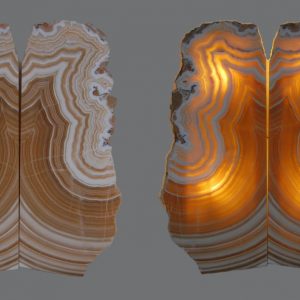

So I still say maybe possible.. not a great wall scale of course
still i say for what purpose of this great detail..
if you cannot see it by the naked eye without a proper tool of magnification.
to see it or a Magnifying Refection tool to see the Bracelet Jewel on a Background
Is the Main Question Here BYRD..
we are talking 3,500 years ago here BRYD
There is Similar Work of the Sumerian // Assyrian Cylinder Seals
even a Griffin on them
theses two are in between 1400 - 1900 BC
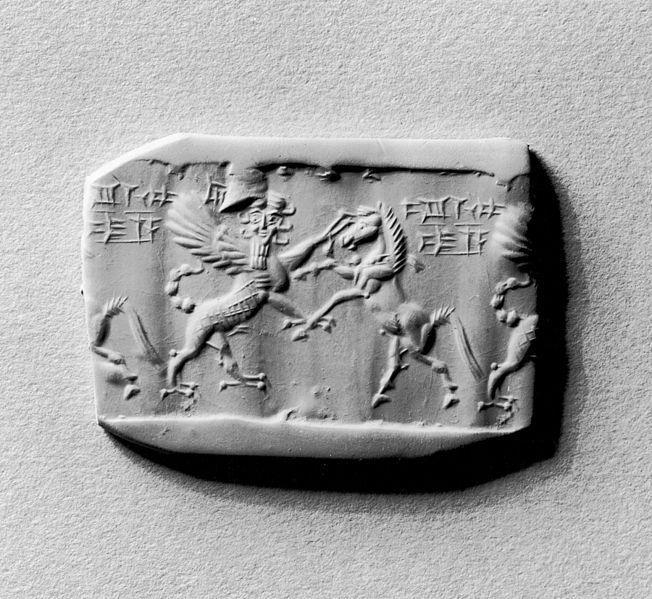
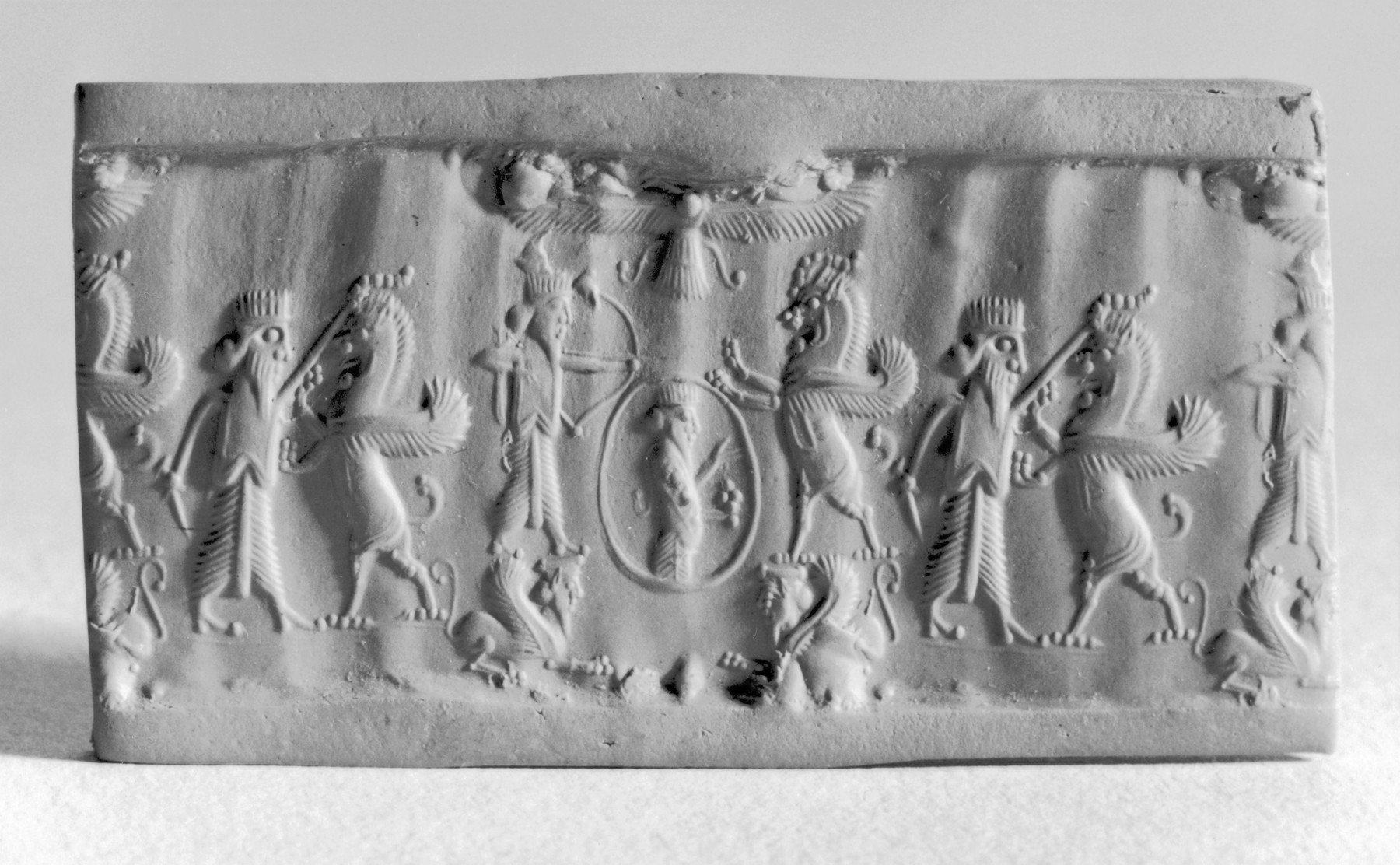
around close of the same time period
but nothing like what we see in the Pyros Agate Stone Jewel..
a reply to: Byrd
Thanks for your post. You remain one of my most respected members.
Ahem. In this case I was pitching a rhetorical question to highlight the unknown artists of history. When I wrote the post I was thinking of the artists of Chauvet and those who have followed in anonymity - gifted and unknown.
I was in philosophical mode.
Thanks for your post. You remain one of my most respected members.
Ahem. In this case I was pitching a rhetorical question to highlight the unknown artists of history. When I wrote the post I was thinking of the artists of Chauvet and those who have followed in anonymity - gifted and unknown.
I was in philosophical mode.
Ahem. In this case I was pitching a rhetorical question to highlight the unknown artists of history. When I wrote the post I was thinking of the artists of Chauvet and those who have followed in anonymity - gifted and unknown.
I really wish we had the names of some of these artists... or even the workshops that produced them. I was looking at votive statues this year for a paper on Egyptology and there were two that I thought might have come from the same city or the same workshop at two different times... however there's no way of knowing.
edit on 15-11-2017 by Byrd because: (no reason given)
a reply to: Byrd
I think we're similar in that regard. Just recently I contacted a department in Wales to try and identify a 19th Century stonemason who specialised in graves. He worked off templates, but some more creative, personal commissions caught my eye and got me wondering if there were any photos or biographies of his family or business. One of the commissions is called the 'Wyatt pyramid' at Llandegai although it wasn't what caught my attention. Typical of council departments - no reply.
Sometimes it's not the knowing, it's the finding out. It sounds like you've found an interesting pursuit.
I think we're similar in that regard. Just recently I contacted a department in Wales to try and identify a 19th Century stonemason who specialised in graves. He worked off templates, but some more creative, personal commissions caught my eye and got me wondering if there were any photos or biographies of his family or business. One of the commissions is called the 'Wyatt pyramid' at Llandegai although it wasn't what caught my attention. Typical of council departments - no reply.
I was looking at votive statues this year for a paper on Egyptology and there were two that I thought might have come from the same city or the same workshop at two different times... however there's no way of knowing.
Sometimes it's not the knowing, it's the finding out. It sounds like you've found an interesting pursuit.

the Griffin Warrior stone ( Pylos ) ..More Liike this ( the Pattern )
not much like the common known Agate
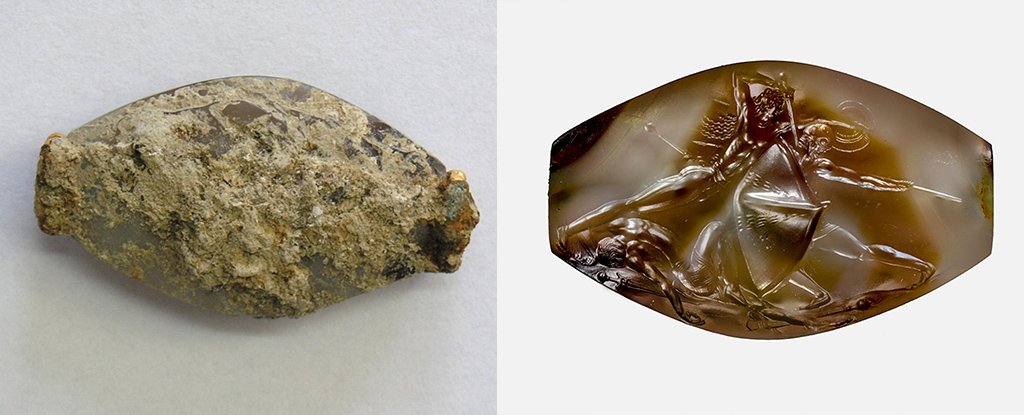
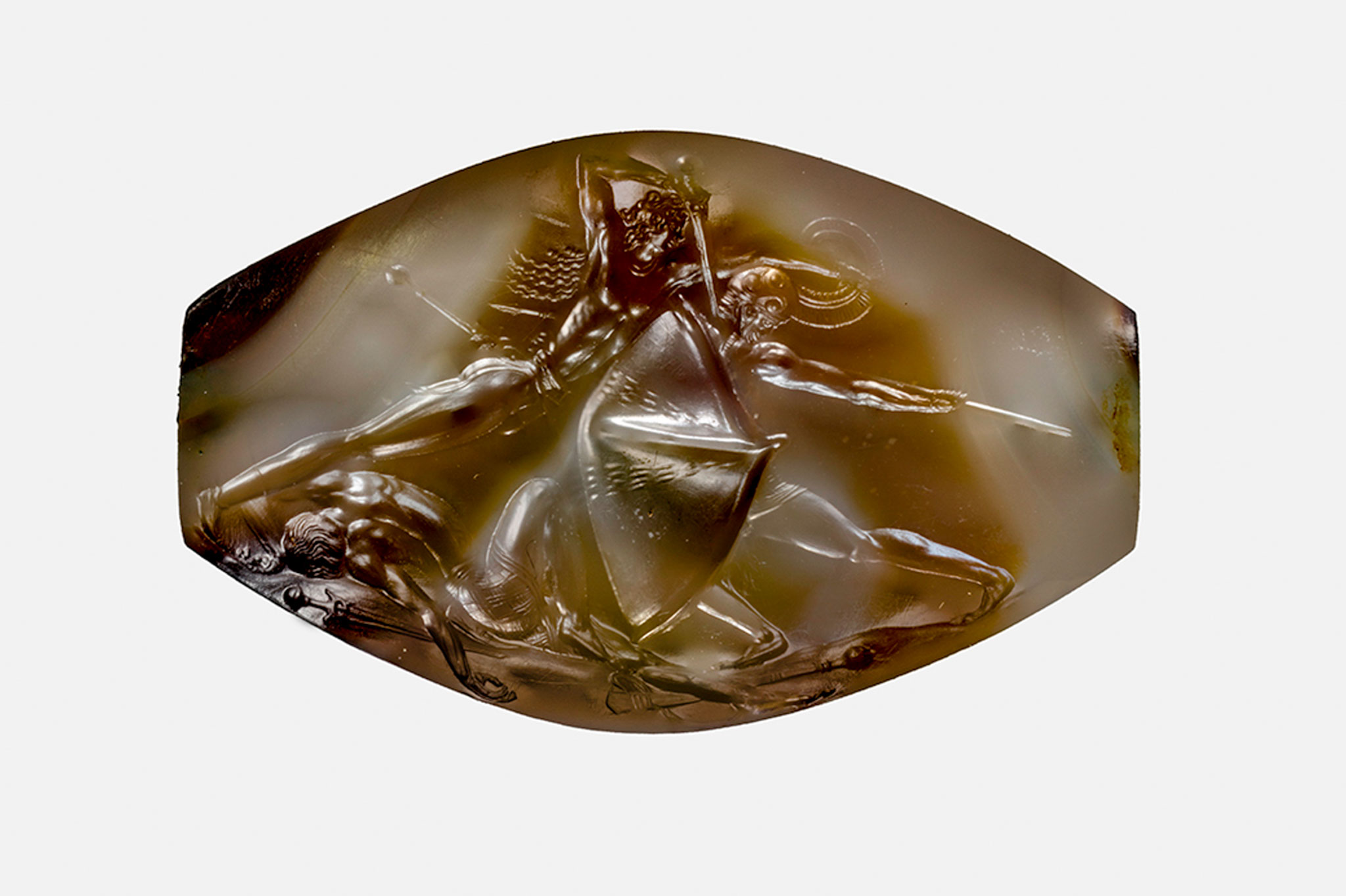
Had too Post this
Recently was thinking where had i seen this action before
The plunge strait into the neck Strait Down with the Sword ..
then I remembered..
www.youtube.com...
more Depth about the Sword that was found in the Griffin warrior Grave
and on the ( wristband Agate Stone Pylos )
Just scroll down on the Page too you come across it
The Greek Age of Bronze
Swords/Daggers
www.salimbeti.com...
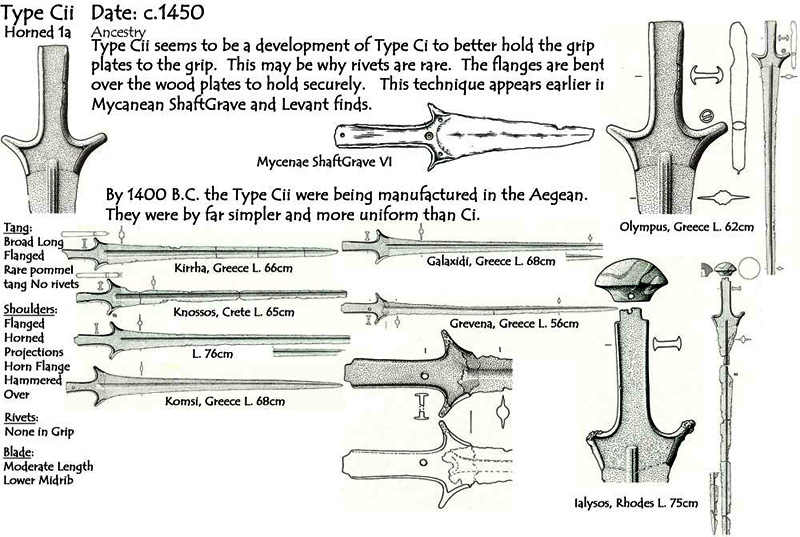
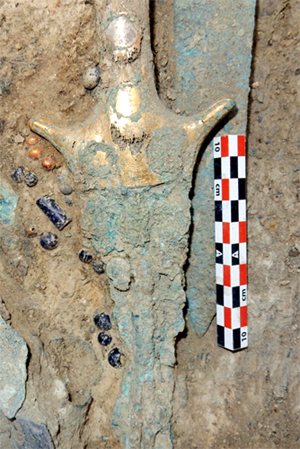
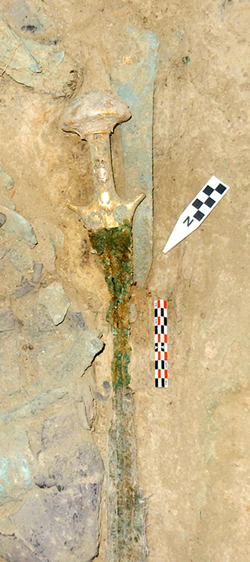
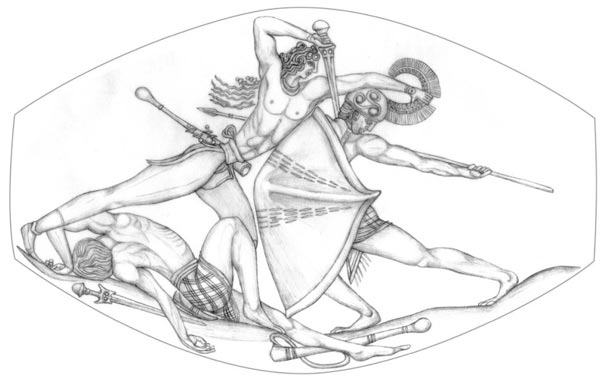
and from the same Webpage
its the Same Scene as the Pylos Stone
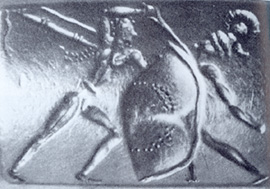
Also in this seal coming from the same shaft-grave an A Type sword is more likely represented.
It is used in a thrusting action by the warrior on the left side. behing him the scabbard of the sword is also visible.
It seems decorated with four small bands (or two ridged plates) and a lower tassel with fringed elements.
and This...
is this representing a Before Scene ???
a related scene ??

edit on 42017ThursdayfAmerica/Chicago11319 by Wolfenz because: (no reason given)
a reply to: soberbacchus
The intricate details are really finely crafted. According to the NatGeo article, the stone is 1.4 inches in length (or about 3.6 cm). Just to provide a sense of scale, I created a collage with a match for comparison, matches are usually about 4 cm in length.
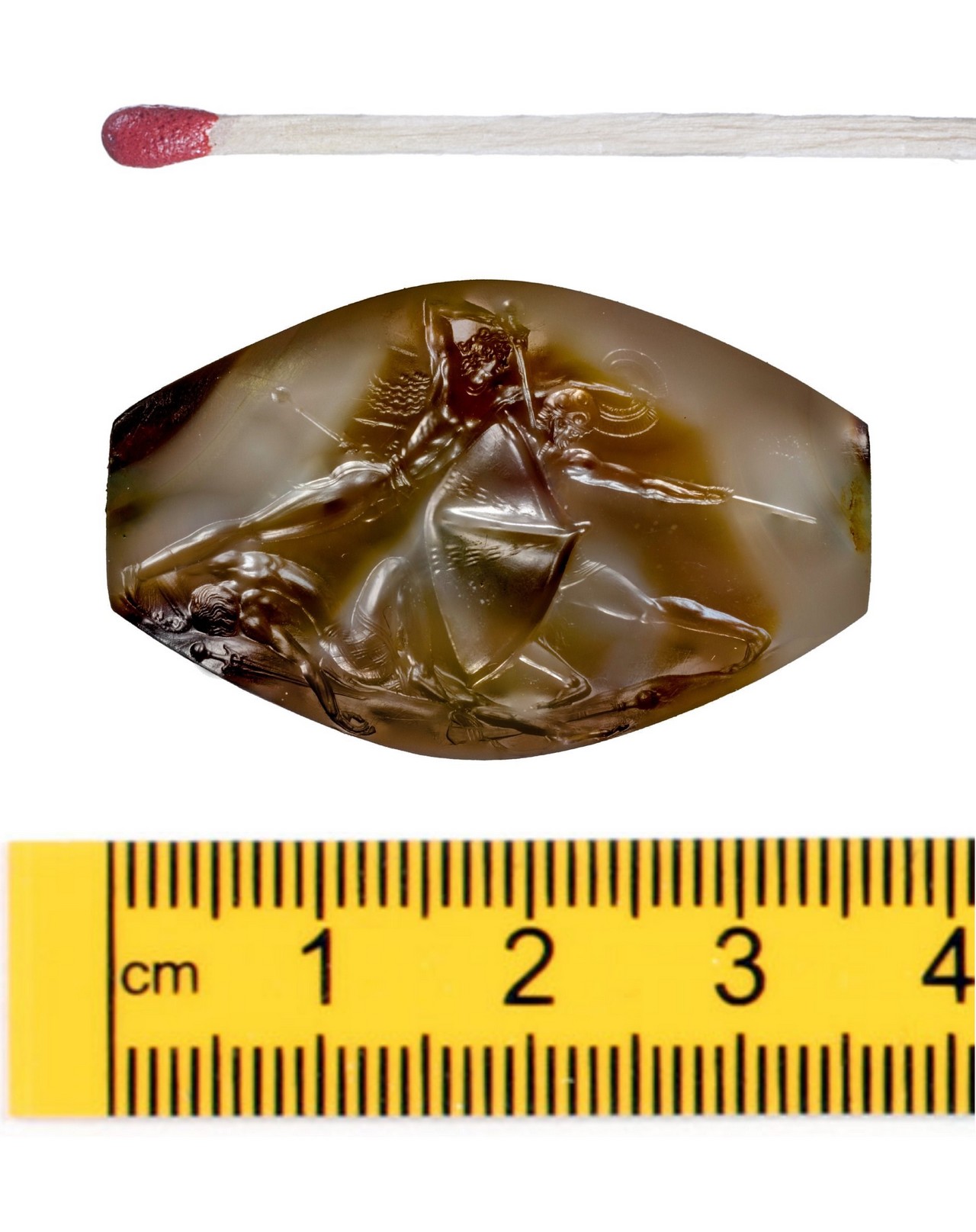
Match head up close:

Although we're not dealing with nano-scale features here, the smallest details are well within the range of some tens of micrometers which is quite remarkable.
The intricate details are really finely crafted. According to the NatGeo article, the stone is 1.4 inches in length (or about 3.6 cm). Just to provide a sense of scale, I created a collage with a match for comparison, matches are usually about 4 cm in length.

Match head up close:

Although we're not dealing with nano-scale features here, the smallest details are well within the range of some tens of micrometers which is quite remarkable.
edit on 16-11-2017 by jeep3r because: new image
originally posted by: punkinworks10
a reply to: soberbacchus
The Minoans also had a heavy presence in britain
Okay, link me.
Harte
originally posted by: Harte
originally posted by: punkinworks10
a reply to: soberbacchus
The Minoans also had a heavy presence in britain
Okay, link me.
Harte
Well seeing he said A Heavy Presence according too BBC he is right ..
well more less the Influence ,
and whos to say a Travel for Trade, Here and there
Ancient-genome study finds Bronze Age ‘Beaker culture’ invaded Britain
Famous bell-shaped pots associated with group of immigrants who may have displaced Neolithic farmers.
www.nature.com...
Bronze Age Britain
www.bbc.co.uk...
Before its entry into Britain, the Bronze Age was in full swing in Europe.The island of Crete was centre for the expansion of the bronze trade to Europe. The Mycenaeans created the finest bronze weapons. They came from southern Russia at around 2,000 BC, and settled in the lowlands of Greece.
There they began to trade with the Minoans. They built a large navy, and began to attack nearby lands. Over time they adapted to the Minoan way of life,and eventually, around 1,400 BC, became the major power in the Aegean Sea.
so we all Happy ...
a reply to: Wolfenz
It's quite a stretch to claim that the Bell Beaker Culture were Minoan though, don't you think? Their earliest archaeological remains predate Bronze Age in the late Neolithjc/ early Chalcolithic and I've seen no genetic studies that tie them to the Minoans so how exactly are you tying them in with a Minoan presence in Britain? I'm genuinely confused, not trying to give you a hard time for once!
It's quite a stretch to claim that the Bell Beaker Culture were Minoan though, don't you think? Their earliest archaeological remains predate Bronze Age in the late Neolithjc/ early Chalcolithic and I've seen no genetic studies that tie them to the Minoans so how exactly are you tying them in with a Minoan presence in Britain? I'm genuinely confused, not trying to give you a hard time for once!
new topics
-
Israel attacking Iran again.
Middle East Issues: 11 minutes ago -
Michigan school district cancels lesson on gender identity and pronouns after backlash
Education and Media: 15 minutes ago -
When an Angel gets his or her wings
Religion, Faith, And Theology: 1 hours ago -
Comparing the theology of Paul and Hebrews
Religion, Faith, And Theology: 1 hours ago -
Pentagon acknowledges secret UFO project, the Kona Blue program | Vargas Reports
Aliens and UFOs: 2 hours ago -
Boston Dynamics say Farewell to Atlas
Science & Technology: 3 hours ago -
I hate dreaming
Rant: 3 hours ago -
Man sets himself on fire outside Donald Trump trial
Mainstream News: 5 hours ago -
Biden says little kids flip him the bird all the time.
Politicians & People: 5 hours ago -
The Democrats Take Control the House - Look what happened while you were sleeping
US Political Madness: 6 hours ago
top topics
-
The Democrats Take Control the House - Look what happened while you were sleeping
US Political Madness: 6 hours ago, 16 flags -
In an Historic First, In N Out Burger Permanently Closes a Location
Mainstream News: 8 hours ago, 14 flags -
Biden says little kids flip him the bird all the time.
Politicians & People: 5 hours ago, 8 flags -
A man of the people
Medical Issues & Conspiracies: 13 hours ago, 8 flags -
Man sets himself on fire outside Donald Trump trial
Mainstream News: 5 hours ago, 7 flags -
Pentagon acknowledges secret UFO project, the Kona Blue program | Vargas Reports
Aliens and UFOs: 2 hours ago, 5 flags -
4 plans of US elites to defeat Russia
New World Order: 15 hours ago, 4 flags -
Sheetz facing racial discrimination lawsuit for considering criminal history in hiring
Social Issues and Civil Unrest: 6 hours ago, 3 flags -
Boston Dynamics say Farewell to Atlas
Science & Technology: 3 hours ago, 3 flags -
Are you ready for the return of Jesus Christ? Have you been cleansed by His blood?
Religion, Faith, And Theology: 11 hours ago, 3 flags
active topics
-
Israel attacking Iran again.
Middle East Issues • 4 • : Freeborn -
Michigan school district cancels lesson on gender identity and pronouns after backlash
Education and Media • 2 • : MetalThunder -
Candidate TRUMP Now Has Crazy Judge JUAN MERCHAN After Him - The Stormy Daniels Hush-Money Case.
Political Conspiracies • 402 • : Zanti Misfit -
The Democrats Take Control the House - Look what happened while you were sleeping
US Political Madness • 62 • : Kaiju666 -
Thousands Of Young Ukrainian Men Trying To Flee The Country To Avoid Conscription And The War
Other Current Events • 50 • : DBCowboy -
I hate dreaming
Rant • 6 • : Hecate666 -
Israeli Missile Strikes in Iran, Explosions in Syria + Iraq
World War Three • 102 • : DumbNut -
Man sets himself on fire outside Donald Trump trial
Mainstream News • 32 • : cherokeetroy -
Pentagon acknowledges secret UFO project, the Kona Blue program | Vargas Reports
Aliens and UFOs • 5 • : Ophiuchus1 -
-@TH3WH17ERABB17- -Q- ---TIME TO SHOW THE WORLD--- -Part- --44--
Dissecting Disinformation • 546 • : MetalThunder
